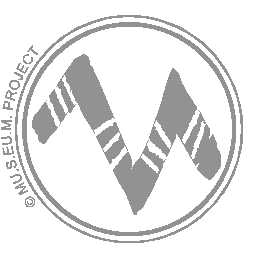|
||||||||||||||||||||||||||||||||
|
|
Museum of: Budapest | |||||||||||||||||||||||||||||||
| Name of the artefact: Vessel with asymmetrical handle | ||||||||||||||||||||||||||||||||
|
The settlement on the banks of the Danube, belonging to
the Bell Beaker Csepel Group, was excavated for a stretch of 3000 m2
within which the archaeologists found a circular ended, multi-spaced,
pillar-based house. It was surrounded by refuse-pits and clay-pits.
Farther off from both the settlement and the Danube, in the burial place
of the settlers, a group of burials with contracted skeletons and cremated
urn-graves came to the surface. The moustache-designed vessel was found in
several levels of the charred, ashy filling of a pit nearby the house,
presumably because the pottery was broken deliberately. |
||||||||||||||||||||||||||||||||
|
WHERE IS IT AND MAIN
CHARACTERISTICS |
STATE |
|||||||||||||||||||||||||||||||
|
Department: |
Department of Prehistoric and Migration
Period |
Preservation: |
Very good | |||||||||||||||||||||||||||||
|
Inventory number: |
BTM Ő/149 |
Restauration: |
Restored | |||||||||||||||||||||||||||||
|
Name of the artefact: |
Vessel with asymmetrical
handle |
Completeness: |
Complete | |||||||||||||||||||||||||||||
|
Object type: |
Vessel/Anphora |
|||||||||||||||||||||||||||||||
|
Material: |
Clay |
|||||||||||||||||||||||||||||||
|
Methof of manufacture: |
Hand made |
|||||||||||||||||||||||||||||||
|
Decoration
type: |
Incision |
|||||||||||||||||||||||||||||||
|
Distinctive mark: |
- |
|||||||||||||||||||||||||||||||
|
DIMENSIONS |
PERIOD OF USE |
|||||||||||||||||||||||||||||||
|
Length (mm): |
- |
Epoque: |
Bronze Age |
|||||||||||||||||||||||||||||
|
Heigth
(mm): |
225 |
Culture: |
Bell Beaker Csepel Group |
|||||||||||||||||||||||||||||
|
Diameter
(mm): |
155 (rim); 100 (bottom) |
Period: |
Early Bronze Age |
|||||||||||||||||||||||||||||
|
Width (mm): |
- |
Face: |
Early |
|||||||||||||||||||||||||||||
|
Thickness (mm): |
- |
Absolute chronology: |
2500-2100 BC |
|||||||||||||||||||||||||||||
|
Weight
(g): |
- |
|||||||||||||||||||||||||||||||
DISCOVERY |
||||||||||||||||||||||||||||||||
|
Date: |
1988 |
Country: |
Hungary |
|||||||||||||||||||||||||||||
|
District: |
Pest county |
Town hall affiliation: |
- |
|||||||||||||||||||||||||||||
|
Village: |
- |
Discovery findspot: |
Szigetszentmiklós-Üdülősor |
|||||||||||||||||||||||||||||
|
Condition of discovery: |
Archaeological excavation |
Discovery type: |
Pit |
|||||||||||||||||||||||||||||
|
ANALYSES – DETERMINATIONS |
FILLED IN BY |
|||||||||||||||||||||||||||||||
|
Type: |
- |
Name: |
Anna Endrődi |
|||||||||||||||||||||||||||||
|
Laboratory: |
- |
Institution: |
Budapest History Muse |
|||||||||||||||||||||||||||||
|
No./Code: |
- |
Date: |
20/10/2005 |
|||||||||||||||||||||||||||||
|
DEEPENINGS |
||||||||||||||||||||||||||||||||
|
Morphology of the object: |
||||||||||||||||||||||||||||||||
|
The vessel has a cylindrical neck, its rim slightly
turning outwards, widening out in the lower one-third of the pottery. The
wide strap-handle on one side starts from the rim and leans on the
widening of the neck, while on the opposite side a small subcutaneous
handle can be found. |
||||||||||||||||||||||||||||||||
|
Decoration: |
||||||||||||||||||||||||||||||||
|
The vessel is reddish-brown, burnished and decorated
with incised bands of motifs. Its wide strap-handle is decorated with a
herring-bone pattern, below it on the side a moustache-decoration is shown
in relief. The prehistoric potter, wanting to achieve symmetry, imitated
the strap-handle on the opposite side with vertical lines (and incised
zigzag motifs in between), which terminate in the subcutaneous handle.
Under this the moustache-design reappears. |
||||||||||||||||||||||||||||||||
|
Inscription: |
||||||||||||||||||||||||||||||||
|
- |
||||||||||||||||||||||||||||||||
|
Analogies: |
||||||||||||||||||||||||||||||||
|
- |
||||||||||||||||||||||||||||||||
|
Interpretation: |
||||||||||||||||||||||||||||||||
|
This piece of pottery is unique because the analysis of
its decorational patterns has made it clear that it carries the stylistic
characteristics of several contemporary cultures. Vessels with
asymmetrical handles are known from the Early Bronze Age Makó culture.
This decorational style originates in the Northern Balkan region. The form
of the vessel – especially the cylindrical neck shape – can be found in
the Early Bronze Age Somogyvár culture as well, while there is also a
similarity with the „becher” type from the later phase of corded ware. The
incised zigzag motif-bands are unique to the Bell Beaker culture, although
they made more use of the stamp technique to decorate their pottery. The
moustache-design in relief is (rarely) used with the so-called
accompanying ceramics (Beigleitkeramik), while it also occurs in the
Proto-Nagyrév circle. The exceptionally decorated pottery, probably
serving exceptional functions as well, can be dated to the early phase of
the Bell Beaker Csepel Group, in which the characteristic features of the
Balkan-Aegean regions mix with those of the pottery ware of Makó,
Proto-Nagyrév and the Bell Beaker cultures. |
||||||||||||||||||||||||||||||||
|
Bibliography: |
||||||||||||||||||||||||||||||||
|
Anna Endrődi The settlement and cemetery of the
Bell-Beaker Culture in the district of Szigetszentmiklós.in:
Archaeological researches on the line of Motorway M0. Budapest 1992
83-201. Budapest History Museum Anna Endrődi Results of settlement
archaeology in Bell Beaker Culture research in Hungary BAR S690 (1998)
141-161. In: Some New Approaches to the Bell Beaker „Phenomenon”-Lost
Paradise...?: Proceedings of the 2nd Meeting of the „Association
Archéologie et Gobelets „ Feldberg (Germany), 18-20th April 1997. Ed:
Marion Benz, Samuel van Willigen. (England) |
||||||||||||||||||||||||||||||||

